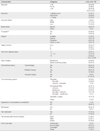Abstract
Purpose
The purpose of the study was to identify degrees of pain, menopause symptoms, and quality of life, and to identify factors influencing quality of life of patients with breast cancer who were on hormone therapy.
Methods
A cross-sectional survey design was utilized. Data were collected using questionnaires from 110 patients with breast cancer who had been on hormone therapy for 3 months or more and were being treated at a university hospital in Seoul. Data were analyzed using χ2-test, t-test, ANOVA, Pearson correlation coefficient and multiple linear regression.
Results
Mean age of the participants was 53.56 (SD=6.67) and 54 (51.4%) had stage 0 or I at the time of diagnosis. Most of the participants reported having pain and menopause symptoms (88.2% and 95.5% respectively). The mean score for quality of life was 87.84±21.17. Pain, menopause symptoms and quality of life had strong correlations with each other (p<.005). Quality of life was explained by menopause symptoms (β= -.71), economic status (β=.20) and occupation (β=.16).
Figures and Tables
References
1. Seo HJ. A comparison of the cancer incidence rates between KCCR's registered cancer statistics and NHIC's data of insurance claims [master's thesis]. Seoul: Korea University;2012.
2. Korean Breast Cancer Society. The breast. 2nd ed. Seoul: Ilchokak Publishing Co;2005.
3. Fenlon DR, Corner JL, Haviland J. Menopausal hot flushes after breast cancer. Eur J Cancer Care (Engl). 2009; 18(2):140–148. http://dx.doi.org/10.1111/j.1365-2354.2007.00902.x.
4. Dorjgochoo T, Gu K, Kallianpur A, Zheng Y, Zheng W, Chen Z, et al. Menopausal symptoms among breast cancer patients 6 months after diagnosis: A report from the Shanghai breast cancer survival study. Menopause. 2009; 16(6):1205–1212. http://dx.doi.org/10.1097/gme.0b013e3181aac32b.
5. Patterson RE, Saquib N, Natarajan L, Rock CL, Parker BA, Thomson CA, et al. Improvement in self-reported physical health predicts longer survival among women with a history of breast cancer. Breast Cancer Res Treat. 2011; 127(2):541–547. http://dx.doi.org/10.1007/s10549-010-1236-x.
6. Oberguggenberger A, Hubalek M, Sztankay M, Meraner V, Beer B, Oberacher H, et al. Is the toxicity of adjuvant aromatase inhibitor therapy underestimated? Complementary information from patient-reported outcomes (PROs). Breast Cancer Res Treat. 2011; 128(2):553–561. http://dx.doi.org/10.1007/s10549-011-1378-5.
7. Fontaine C, Meulemans A, Huizing M, Collen C, Kaufman L, De Mey J, et al. Tolerance of adjuvant letrozole outside of clinical trials. Breast. 2008; 17(4):376–381. http://dx.doi.org/10.1016/j.breast.2008.02.006.
8. Davies C, Godwin J, Gray R, Clarke M, Cutter D, Darby S, et al. Relevance of breast cancer hormone receptors and other factors to the efficacy of adjuvant tamoxifen: Patient-level meta-analysis of randomised trials. Lancet. 2011; 378(9793):771–784. http://dx.doi.org/10.1016/s0140-6736(11)60993-8.
9. Hwang SY. Factors affecting quality of life among breast cancer survivors. Ment Health Soc Work. 2009; 33:257–287.
10. Mao JJ, Stricker C, Bruner D, Xie S, Bowman MA, Farrar JT, et al. Patterns and risk factors associated with aromatase inhibitor-related arthralgia among breast cancer survivors. Cancer. 2009; 115(16):3631–3639. http://dx.doi.org/10.1002/cncr.24419.
11. Yun YH, Mendoza TR, Heo DS, Yoo T, Heo BY, Park HA, et al. Development of a cancer pain assessment tool in Korea: A validation study of a Korean version of the brief pain inventory. Oncology. 2004; 66(6):439–444. http://dx.doi.org/10.1159/000079497.
12. Faul F, Erdfelder E, Buchner A, Lang AG. Statistical power analyses using G*Power 3.1: Tests for correlation and regression analyses. Behav Res Methods. 2009; 41(4):1149–1160. http://dx.doi.org/10.3758/brm.41.4.1149.
13. Cella DF, Tulsky DS, Gray G, Sarafian B, Linn E, Bonomi A, et al. The functional assessment of cancer therapy scale: Development and validation of the general measure. J Clin Oncol. 1993; 11(3):570–579.
14. Yoo HJ, Ahn SH, Eremenco S, Kim H, Kim WK, Kim SB, et al. Korean translation and validation of the functional assessment of cancer therapy-breast (FACT-B) scale version 4. Qual Life Res. 2005; 14(6):1627–1632.
15. Cleeland CS, Ryan KM. Pain assessment: Global use of the brief pain inventory. Ann Acad Med Singapore. 1994; 23(2):129–138.
16. Serlin RC, Mendoza TR, Nakamura Y, Edwards KR, Cleeland CS. When is cancer pain mild, moderate or severe? Grading pain severity by its interference with function. Pain. 1995; 61(2):277–284.
17. Heinemann K, Ruebig A, Potthoff P, Schneider HP, Strelow F, Heinemann LA, et al. The menopause rating scale (MRS) scale: A methodological review. Health Qual Life Outcomes. 2004; 2:45. http://dx.doi.org/10.1186/1477-7525-2-45.
18. Reimer T, Gerber B. Quality-of-life considerations in the treatment of early-stage breast cancer in the elderly. Drugs Aging. 2010; 27(10):791–800. http://dx.doi.org/10.2165/11584700-000000000-00000.
19. Safarinejad MR, Shafiei N, Safarinejad S. Quality of life and sexual functioning in young women with early-stage breast cancer 1 year after lumpectomy. Psychooncology. 2013; 22(6):1242–1248. http://dx.doi.org/10.1002/pon.3130.
20. Lee JH. The association of obesity indices and cardiovascular risk in Korean type 2 diabetes. Korean J Obes. 2013; 22(4):212–214. http://dx.doi.org/10.7570/kjo.2013.22.4.212.
21. Park JH, Jun EY, Kang MY, Joung YS, Kim GS. Symptom experience and quality of life in breast cancer survivors. J Korean Acad Nurs. 2009; 39(5):613–621. http://dx.doi.org/10.4040/jkan.2009.39.5.613.
22. Otte JL, Carpenter JS, Zhong X, Johnstone PA. Feasibility study of acupuncture for reducing sleep disturbances and hot flashes in postmenopausal breast cancer survivors. Clin Nurse Spec. 2011; 25(5):228–236. http://dx.doi.org/10.1097/NUR.0b013e318229950b.
23. Carson JW, Carson KM, Porter LS, Keefe FJ, Seewaldt VL. Yoga of awareness program for menopausal symptoms in breast cancer survivors: Results from a randomized trial. Support Care Cancer. 2009; 17(10):1301–1309. http://dx.doi.org/10.1007/s00520-009-0587-5.
24. Toulis KA, Tzellos T, Kouvelas D, Goulis DG. Gabapentin for the treatment of hot flashes in women with natural or tamoxifen-induced menopause: A systematic review and meta-analysis. Clin Ther. 2009; 31(2):221–235. http://dx.doi.org/10.1016/j.clinthera.2009.02.006.
25. Park J. Symptom cluster and status of physical function in women with breast cancer receiving chemotheraopy [master's thesis]. Seoul: Seoul National University;2009.
26. Park H, Yoon HG. Menopausal symptoms, sexual function, depression, and quality of life in Korean patients with breast cancer receiving chemotherapy. Support Care Cancer. 2013; 21(9):2499–2507. http://dx.doi.org/10.1007/s00520-013-1815-6.
27. Kwon EJ, Yi M. Distress and quality of life in breast cancer survivors in Korea. Asian Oncol Nurs. 2012; 12(4):289–296. http://dx.doi.org/10.5388/aon.2012.12.4.289.




 PDF
PDF ePub
ePub Citation
Citation Print
Print







 XML Download
XML Download